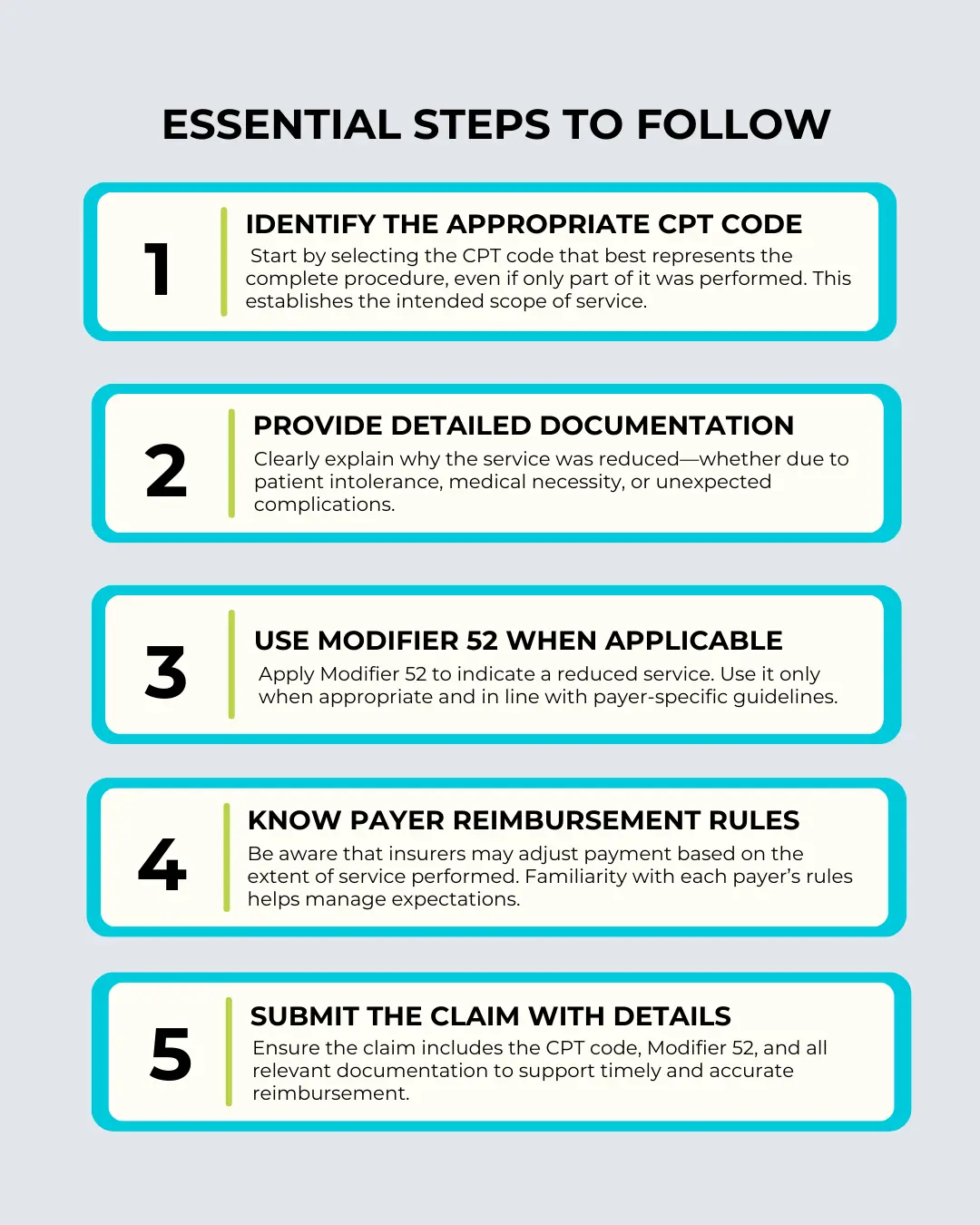In professional medical billing, accuracy is essential to ensure providers receive appropriate reimbursement for the care they deliver. A critical part of this process involves using two-digit codes, known as modifiers, which are added to CPT (Current Procedural Terminology) codes to clarify how a service was performed—especially when it differs from the standard procedure.
Modifier 52 is one such code, used when a service is performed partially or in a reduced manner. In this blog, we’ll explore its purpose, when it’s appropriate to use, and how a medical billing company can help bill correctly when a procedure isn’t completed in full.
What is Modifier 52?
Modifier 52 is used to indicate that a service or procedure was partially or incompletely performed. This typically occurs when a procedure is planned or expected to be more extensive but was reduced in scope for a variety of reasons, such as patient conditions, medical necessity, or other factors. It tells insurers that the service performed was less than what was originally planned, and it might warrant a reduced reimbursement.
For example, if a surgeon is unable to complete a full procedure due to complications, they would apply modifier 52 to inform the payer that the service was not fully carried out.
When to Use Modifier 52
- There are times when a healthcare provider intends to carry out a full procedure but ends up performing only a portion of it. In such cases, it’s important to accurately report the situation for billing purposes. Below are common examples where a procedure is reported as reduced or incomplete:
- Incomplete procedures: Sometimes, a test or treatment cannot be completed due to unforeseen complications or patient intolerance. While part of the service is performed, it doesn’t reach its full scope.
- Patient refusal: A patient may decide not to continue with a procedure after it has already begun. In these cases, only the portion actually performed should be reflected in the billing.
- Medical necessity: A provider may determine that continuing with the full procedure would pose a risk to the patient. When safety concerns limit how much of the service can be completed, this must be documented appropriately.
- Limited scope of service: Occasionally, a service is intentionally performed only in part—such as a partial biopsy or reduced imaging scan—based on clinical needs or patient conditions. It’s essential that claims reflect the actual extent of what was delivered.
Want more information? Read here: Everything You Need to Know About Medical Billing Process
How to Bill with Modifier 52
Billing for a service that was only partially completed requires a thoughtful and accurate approach to ensure proper reimbursement. Below are the essential steps to follow when reporting such cases:

Challenges with Modifier 52
Although this billing code plays an important role in reflecting reduced or incomplete services, it can come with challenges. One major issue is that insurance payers may not always grasp the full clinical context behind a partially performed procedure, which can result in denied claims or lower reimbursement than expected.
To mitigate these issues, providers should ensure that:
- Thorough documentation is included with each claim, clearly explaining why the procedure was incomplete and why Modifier 52 is being applied.
- Clear communication with insurers is maintained, particularly if there is any ambiguity regarding the reduced services.
Additionally, some healthcare providers may find it difficult to determine the correct reduced reimbursement for services with Modifier 52. To avoid claim denials or underpayments, it’s essential to ensure accurate coding, thorough documentation, and a clear understanding of payer-specific guidelines.
Why Proper Billing with Modifier 52 Matters
Accurate billing with modifier 52 is crucial for several reasons. Firstly, it ensures that healthcare providers are appropriately compensated for the services they perform, even if those services are incomplete. Secondly, it helps maintain the integrity of the claims process and reduces the likelihood of audits or fines due to incorrect billing practices.
Moreover, managing the financial side of healthcare goes far beyond simply submitting claims. It involves optimizing every step—from the patient’s first visit to receiving the final payment. Accurately reporting reduced or incomplete services helps ensure that claims are processed efficiently, reducing the risk of errors and supporting the financial health of the practice.
Key Takeaways
- When a medical service is started but not completed in full, it’s important to reflect that accurately in the billing process. This helps ensure transparency and aligns the claim with what was actually performed.
- Proper documentation is key—providers must clearly explain why the full procedure wasn’t carried out. This could be due to patient discomfort, clinical concerns, or unforeseen complications.
- Healthcare organizations should also be aware that reimbursement may be adjusted when only part of a service is performed. Detailed records and correct reporting support these claims and help prevent denials.
- Medical coding plays a vital role in this process. Coders must be knowledgeable about how to represent reduced services within CPT guidelines to avoid errors or delays.
- For those unsure about how to navigate these situations, working with experienced billing professionals can provide essential guidance. Their expertise helps ensure that claims are submitted accurately and in compliance with payer requirements, leading to quicker and more reliable reimbursements.
Conclusion
In summary, Modifier 52 plays an important role in medical billing, particularly when a service is only partially completed. By applying it correctly and following established billing protocols, healthcare providers can still receive appropriate reimbursement, even if the procedure wasn’t performed in full. For practices aiming to streamline operations and stay aligned with payer requirements, implementing RCM healthcare solutions can help minimize administrative stress and support stronger financial performance.
If your team is facing challenges with billing or needs guidance on handling complex coding scenarios, seeking support from knowledgeable professionals can help ensure compliance and long-term success.
Looking more details? Keep going: How Revenue Cycle Specialist Optimize Back Office RCM
FAQS (Frequently Asked Questions)
1. What does billing for a reduced service mean?
It means the full procedure wasn’t completed, and only the portion performed is billed.
2. When should I use a reduced service code?
Use it when a procedure is partially completed due to factors like patient discomfort, refusal, or medical necessity.
3. How should I document a reduced service?
Document why the service was reduced, such as patient condition or medical complications.
4. Will reimbursement be lower for reduced services?
Yes, reimbursement is typically reduced for incomplete procedures.
5. What’s needed when submitting a claim for reduced services?
Ensure the correct CPT code, the appropriate reduced service code, and supporting documentation are included.







